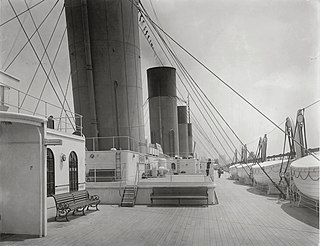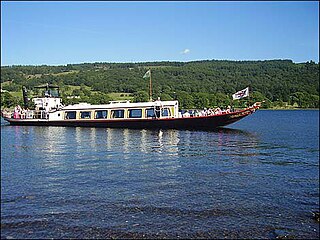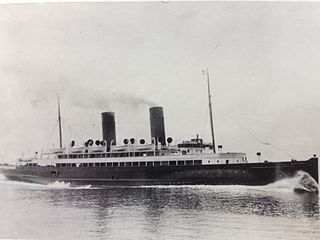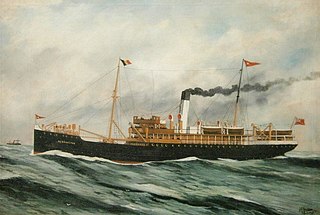
A deck is a permanent covering over a compartment or a hull of a ship. On a boat or ship, the primary or upper deck is the horizontal structure that forms the "roof" of the hull, strengthening it and serving as the primary working surface. Vessels often have more than one level both within the hull and in the superstructure above the primary deck, similar to the floors of a multi-storey building, that are also referred to as decks, as are certain compartments and decks built over specific areas of the superstructure. Decks for some purposes have specific names.

The Dee Why and Curl Curl, were two identical steam ferries servicing Sydney Harbour's Circular Quay to Manly service. Both commissioned in 1928, they were the largest ferries on Sydney Harbour until the 1938 introduction of the South Steyne.

SS Servia, also known as RMS Servia, was a successful transatlantic passenger and mail steamer of revolutionary design, built by J & G Thomson of Clydebank and launched in 1881. She was the first large ocean liner to be built of steel instead of iron, and the first Cunard ship to have an electric lighting installation. For these and other reasons, maritime historians often consider Servia to be the first "modern" ocean liner.

The Olympic-class ocean liners were a trio of British ocean liners built by the Harland & Wolff shipyard for the White Star Line during the early 20th century. They were Olympic (1911), Titanic (1912), and Britannic (1915). All three were designed to be the largest and most luxurious passenger ships in the world, designed to give White Star an advantage in the transatlantic passenger trade.

The steam yacht Gondola is a rebuilt Victorian, screw-propelled, steam-powered passenger vessel on Coniston Water, England. Originally launched in 1859, she was built for the steamer service carrying passengers from the Furness Railway and from the Coniston Railway. She was in commercial service until 1936 when she was retired, being converted to a houseboat in 1946. In 1979, by now derelict, she was given a new hull, engine, boiler and most of the superstructure. She is back in service as a passenger boat, still powered by steam and now operated by the National Trust.

TSS (RMS) Ben-my-Chree (III) No. 118605 – the third vessel in the company's history to be so named – was a passenger steamer operated by the Isle of Man Steam Packet Company between 1908 and 1915. Ben-my-Chree was requisitioned by the Admiralty in 1915 and converted to a Seaplane Carrier. Commissioned as HMS Ben-my-Chree she was sunk by Turkish batteries on 11 January 1917.

The MV Baragoola is a ferry formerly operated by the Port Jackson & Manly Steamship Company and its successors on the Manly service. The sixth and final of the Binngarra type Manly ferries, the vessel entered service in 1922. Since its decommissioning as a ferry in 1983, the vessel has since been had a number of owners who have attempted to find a new role and restore it. Since 2003, it has been laid up at Balls Head Bay on the north side of Sydney Harbour as attempts to restore the vessel have continued.

TSS (RMS) Mona's Queen (III) No. 145308, was a ship built for the Isle of Man Steam Packet Company in 1934. The steamer, which was the third vessel in the company's history to bear the name, was one of five ships to be specially commissioned by the company between 1927 and 1937. They were replacements for the various second-hand steamers that had been purchased to replace the company's losses during the First World War. However, the life of the Mona's Queen proved to be short: six years after being launched she was sunk by a sea mine during the Dunkirk evacuation on 29 May 1940.

SS (RMS) Empress Queen was a steel paddle steamer, the last of its type ordered by the Isle of Man Steam Packet Company. She was chartered by the Admiralty in 1915 and used for trooping duties until she ran aground off Bembridge, Isle of Wight, England in 1916 and was abandoned.

The SS Yarmouth was a steel-hulled steamship owned by the Great Eastern Railway. She was built in 1903 for use on their cargo service between Harwich, Essex, and the Hook of Holland and Rotterdam, the Netherlands. She was lost at sea with all hands on 27 October 1908.

The MV North Head was a ferry operated by the Port Jackson & Manly Steamship Company and its successors on the Manly service from 1913 until 1985.
City of Lowell was a twin screw passenger steamer launched on 21 November 1893 by Bath Iron Works and delivered in July 1894 for the Norwich & New York Transportation Company for use on Long Island Sound. The Norwich Line, operated by the New York and New England Railroad, placed the steamer on the overnight service between New York and New London, Connecticut. Passengers connected by rail at New London for Boston and Worcester, Massachusetts. The ship was in commercial operation until 1939 when apparently laid up awaiting scrapping. At the outbreak of World War II City of Lowell was acquired by the War Shipping Administration with eventual transfer of title to the War Department for use as an Army troop transport. The ship was sold to Potomac Shipwrecking Company of Washington, D.C. in November 1946 for scrapping.

TSS Chelmsford was a passenger vessel built for the Great Eastern Railway in 1893.
The TSS Duchess of Devonshire was a passenger vessel built for the Barrow Steam Navigation Company in 1897.
PS Avalon was a passenger vessel built for the Great Eastern Railway in 1864.
SS Lutterworth was a passenger and cargo vessel built for the Manchester, Sheffield and Lincolnshire Railway in 1891.

SS Accrington was a passenger and cargo vessel built for the Great Central Railway in 1910.
SS Chester was a passenger and cargo vessel built for the Manchester, Sheffield and Lincolnshire Railway in 1884.
SS Gainsborough was a passenger and cargo vessel built for the Manchester, Sheffield and Lincolnshire Railway in 1880.
PS Solent was a passenger vessel built for the London and South Western Railway in 1900.












